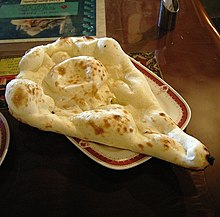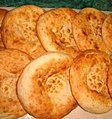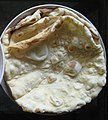Naan
 | |
| Alternative names | Nan, Noon, Paan, Faan |
|---|---|
| Region or state | Central Asia,South Asia,Southeast Asia,and theCaribbean |
| Main ingredients | Flour,yeast,salt,sugar,ghee,water |
Naan(/nɑːn/) is aleavened,oven-baked (usually using atandoor) ortawa-friedflatbread.It is characterized by its light and slightly fluffy texture and golden-brown spots from the baking process.[1]Naan is found in the cuisines mainly ofCentral Asia,theSouth Asia,Southeast Asia,and theCaribbean.[2][3][4]
Primarily composed of white or wheat flour combined with a leavening agent, typically yeast, naan dough develops air pockets that contribute to its fluffy and soft texture. Additional ingredients for crafting naan include warm water, salt, ghee (clarified butter), and yogurt, with optional additions like milk, egg, or honey. Sometimes, baking powder or baking soda is used instead of yeast to reduce the preparation time for the bread.
In the traditional baking process inside a tandoor, naan dough is rolled into balls, flattened, and then pressed against the tandoor's inner walls, which can reach temperatures up to 480 °C (900 °F). This method allows the bread to be baked within minutes, achieving a spotty browning due to the intense heat. Alternatively, naan can be prepared on a stovetop using a flat pan known as a tawa. The pan may be flipped upside down over the flame to achieve the characteristic browning of the bread's surface.
Once baked naan is typically coated with ghee or butter and served warm. This soft and pliable bread frequently accompanies meals, replacing utensils for scooping up dahls, sauces, stews, and curries, or is enjoyed with dryer dishes like tandoori chicken.[5]
Etymology[edit]

The term "naan" comes fromPersiannân(Persian:نان), a generic word for any kind of bread. This word was borrowed into a range of languages in theIndian subcontinentandCentral Asia,where it came to refer to a specific type of bread. The term then spread around the globe along with the style of bread itself.[citation needed]
The earliest known English use of the term occurs in an 1803 travelogue written byWilliam Tooke.[6]While Tooke and other early sources spell it "nan", the spellingnaanhas become predominant since the late 1970s.[7][8]
Varieties[edit]
Indian subcontinent[edit]
Naan spread to theIndian subcontinentduring the IslamicDelhi Sultanateperiod. The earliest mention of naan in the region comes from the memoirs of Indo-Persian Sufi poetAmir Khusrauliving in India during the 1300s AD.Amir Khusraumentions two kinds of naan eaten by Muslim nobles;Naan-e-TunukandNaan-e-Tanuri.Naan-e-Tunukwas a light or thin bread, whileNaan-e-Tanuriwas a heavy bread and was baked in the tandoor.[9]During India’s Mughal era in the 1520s, Naan was a delicacy that only nobles and royal families enjoyed because the art of making Naan was a revered skill, known by few and the lengthy process of making leavened bread. TheAin-i-Akbari,a written record of the third Mughal emperor’s reign, also mentions naan and it was eaten with kebabs or kheema (spiced minced meat) in it. By the 1700s naan had reached the masses in Mughal cultural centers in South Asia.[10]
Indonesia[edit]
InIndonesia,naan is popular inIndian IndonesianandArab Indonesiancommunities as well as inMalay,AcehneseandMinangkabaucommunities–with other variants ofrotilikeroti canai.This dish is usually locally known asroti naanorroti nanand cooked using Indonesian spices, such as garlic with a local taste.[11]
Myanmar[edit]
Naan bya(Burmese:နံပြား) inMyanmaris traditionally served at teahouses with tea or coffee as a breakfast item.[12]It is round, soft, and blistered, often buttered, or with creamypè byouk(boiledchickpeas) cooked with onions spread on top, or dipped withBurmese curry.[12]
| External image | |
|---|---|
China[edit]
TheJingzhoustyle ofguokui,a flatbread prepared inside a cylindrical charcoal oven much like a tandoor, has been described as "Chinese naan".[13]It is also an integral part ofUyghur cuisineand is known in Chinese as bánh nướng lò (náng).[14][15]
Japan[edit]
After being promoted by Kandagawa Sekizai Shoukou in 1968, which is now the sole domestic manufacturer of tandoors, naan is now widely available in Indian-style curry restaurants in Japan, where naan is typically free-flow. Some restaurants bake ingredients such as cheese, garlic, onions, and potatoes into the naan, or cover it with toppings like a pizza.[16][17][18]
Elsewhere[edit]
In 1799, the word naan was introduced into the English language by historian and clergyman William Tooke. Today, naan can be found worldwide in restaurants serving South Asian and Middle Eastern cuisine, and it is available in many supermarkets. Fusion cuisine has introduced new dishes that incorporate naan, including naan pizza and naan tacos and even huevos rancheros (an egg dish) served over naan. Naan pizza is a type ofpizzawhere naan is used as the crust instead of the traditional pizza dough. Chefs such asNigella Lawson,[19]and supermarkets such asWegmans[20]offer recipes for people to make their own naan pizza at home, though it is certainly not traditional.
Gallery[edit]
-
Nan inAfghanistan
-
Nan inKabul,Afghanistan
-
Nan inMazar-e Sharif,Afghanistan
-
Nan inIran
-
Nân-e barbariin Iran
-
Nân-e sangakin Iran
-
Nân-e tâftunin Iran
-
Butter garlic naan
-
Paneer(cheese) naan
-
Burmese nan bya
See also[edit]
References[edit]
- ^Bernard Clayton's New Complete Book of Breads ByBernard Clayton Jr.,Donnie A Cameron.Simon and Schuster. 1987.ISBN9780671602222.
- ^QminArchived24 April 2023 at theWayback Machineby Anil Ashokan, Greg Elms
- ^The Science of Cooking,Peter Barham, Springer: 2001.ISBN978-3-540-67466-5.p. 118.
- ^The Bread Lover's Bread Machine CookbookArchived24 April 2023 at theWayback Machineby Beth Hensperger
- ^"Archived copy".Archivedfrom the original on 28 March 2024.Retrieved28 March2024.
{{cite web}}:CS1 maint: archived copy as title (link) - ^Russia, or a Complete Historical Account of all the Nations which compose that Empire,London, p. 168: "The most common dishes areonoschi,or vermicelli;plav,or boiled rice;nan,pancakes, and the meats which the law permits. "(referring to the eating habits of the central Turks). Other attestations in English can be found in theOxford English Dictionary,s.v.naan.
- ^"Home: Oxford English" Dictionary ".oed.Archivedfrom the original on 29 April 2020.Retrieved6 September2015.
- ^Milton Glaser and Jerome Snyder."Delhi Delights",New York Magazine,August 11, 1975, p. 73
- ^"History of Naan".Times of India. 11 June 2020.Archivedfrom the original on 22 January 2023.Retrieved22 January2023.
- ^Dash, MadhulIka (2015)."Breaking Bread"(PDF).No. May–June. Forbes life india. Forbes.Archived(PDF)from the original on 22 January 2023.Retrieved22 January2023.
- ^"Baking with Eda: 'Naan' Indonesian Flatbread".Archivedfrom the original on 26 October 2020.Retrieved22 May2020.
- ^ab"Eating in Burma".Travelfish.Archivedfrom the original on 29 May 2023.Retrieved29 May2023.
- ^"This 1,000-Year-Old Chinese 'Naan' Was Once Cooked in a Hat, and It's Yummy".Archivedfrom the original on 11 July 2021.Retrieved3 July2021.
- ^"Uighur Nan with Cumin and Onion Recipe".Archivedfrom the original on 4 February 2022.Retrieved4 February2022.
- ^"Have You Ever Seen Uyghur Bazaar Naan? It's So Fluffy and Delicious | TRP".Archivedfrom the original on 4 February 2022.Retrieved4 February2022.
- ^"【 gần ごろ đều に lưu hành るも の 】 “カレーにナン” bổn tràng インド trở lên に phổ cập ・ cự đại hóa ".27 July 2018.Archivedfrom the original on 18 January 2022.Retrieved17 January2022.
- ^"インド người が kinh く Nhật Bản の 「ナン」 một mình すぎる tiến hóa | thực べれば thế giới がわかる! カレー kinh tế quyển".6 May 2019.Archivedfrom the original on 18 January 2022.Retrieved17 January2022.
- ^"Nhật Bản の インド liệu lý cửa hàng の ナンが đại きい lý do | tạp học ネタ trướng".Archivedfrom the original on 18 January 2022.Retrieved17 January2022.
- ^Nigella."NAAN PIZZA - Recipes - Nigella Lawson".nigella.Archivedfrom the original on 9 September 2015.Retrieved6 September2015.
- ^"Recipes - Wegmans".wegmans.Archived fromthe originalon 1 May 2014.Retrieved6 September2015.
External links[edit]
 Media related toNaanat Wikimedia Commons
Media related toNaanat Wikimedia Commons Cookbook:Naanat Wikibooks
Cookbook:Naanat Wikibooks



















